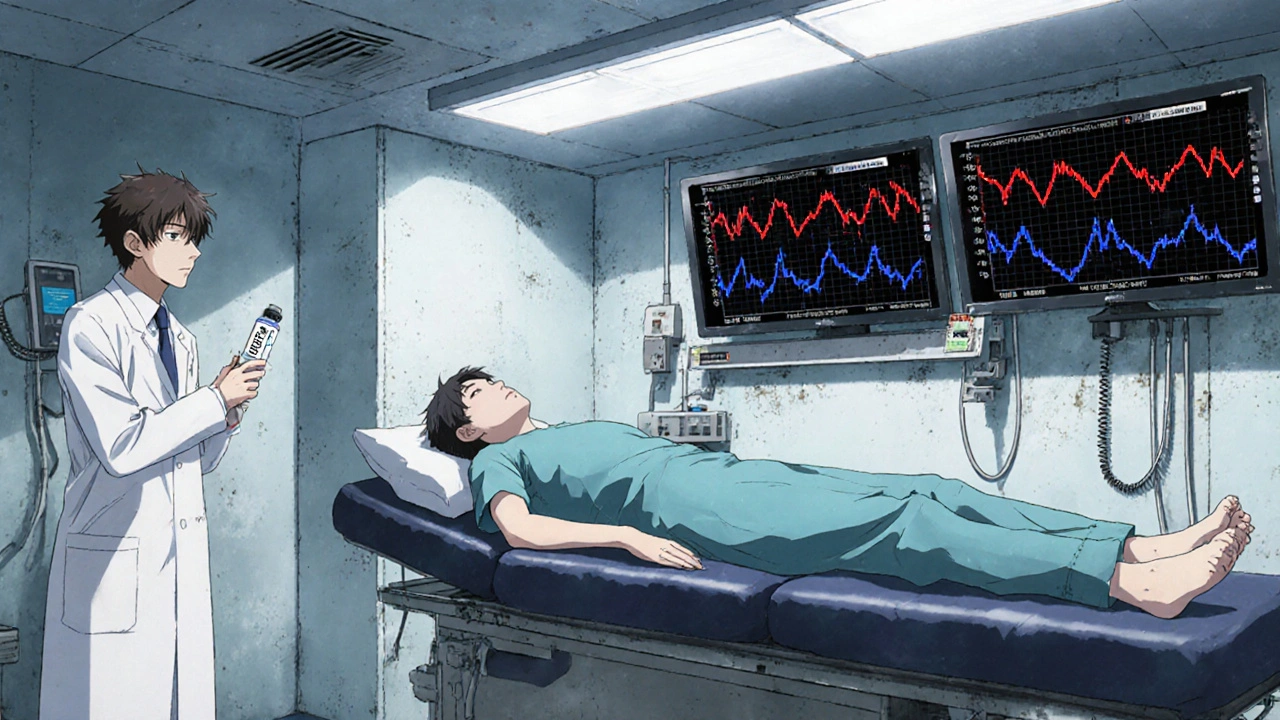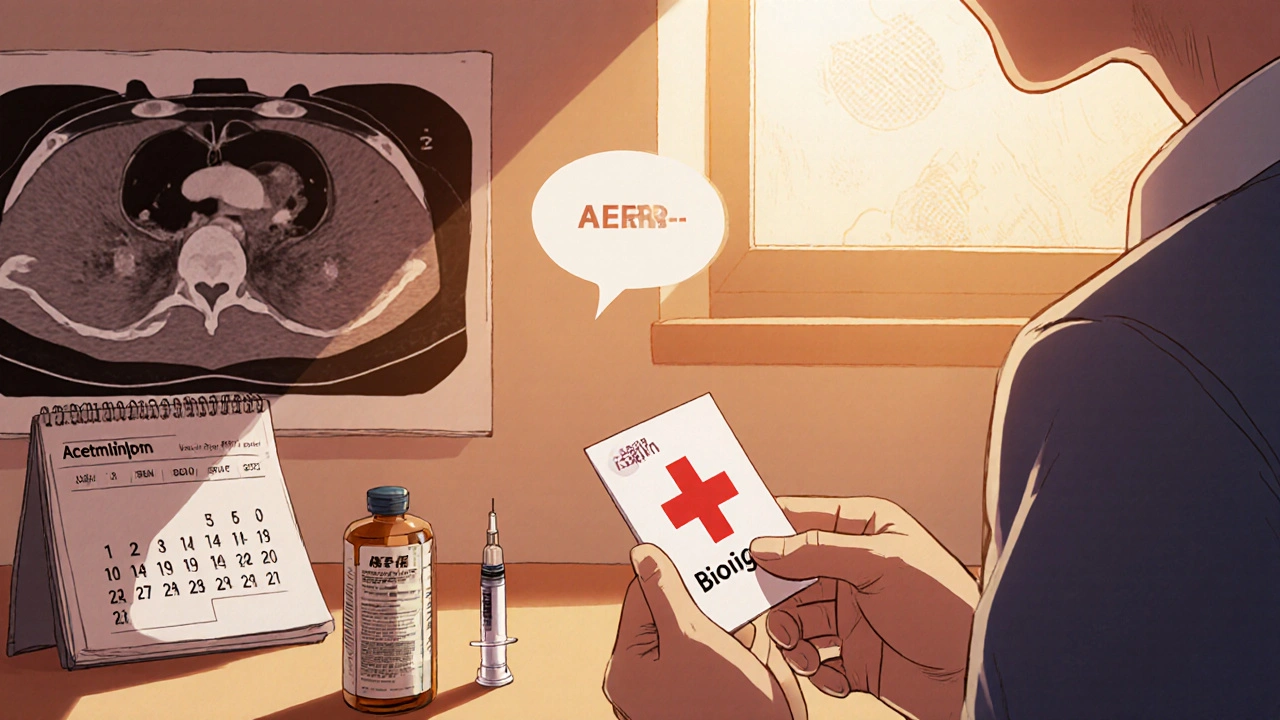AERD Treatment Calculator
How AERD Treatment Works
Based on article data: This calculator compares treatment options using success rates, cost, and time commitments. Results show recommended options based on your profile.
Your Symptoms
Your Preferences
Recommended Options
Aspirin Desensitization
Gold standard treatment
Best for you because:
- Reduces polyp regrowth by 40% (vs. 70-100% without)
- 60% fewer sinus surgeries
Biologic Therapy
Targeted inflammation blocker
Best for you because:
- Reduces polyp size by 50-60%
- May be necessary if desensitization isn't possible
NSAID Avoidance
Non-medication approach
Best for you because:
- Eliminates acute reactions
- Essential for alcohol-sensitive patients
When you hear the term Aspirin-Exacerbated Respiratory Disease (AERD) is a chronic condition that links asthma, recurring nasal polyps, and a heightened reaction to aspirin and other non‑steroidal anti‑inflammatory drugs (NSAIDs), it can feel like a puzzle with three pieces that never quite fit together. This guide walks you through what AERD really is, how to spot it, and which treatments actually work - without drowning you in jargon.
What Makes AERD Different from Ordinary Asthma?
Most people think of asthma as a breathing problem triggered by pollen, dust or exercise. AERD adds two critical layers:
- Asthma that often starts in adulthood rather than childhood.
- Chronic rhinosinusitis with nasal polyps, which are soft tissue growths inside the nose that cause constant congestion.
- A drug hypersensitivity to any medication that blocks cyclooxygenase‑1 (COX‑1), the enzyme aspirin and many NSAIDs inhibit.
The trio of asthma, polyps and COX‑1‑triggered reactions is often called Samter’s Triad, a name that still shows up in older articles.
How the Body Goes Off‑Balance
At the biochemical level, AERD messes with the arachidonic‑acid pathway. Two key messengers swing out of sync:
- Overproduction of leukotriene E4, a powerful bronchoconstrictor that fuels wheezing and sinus inflammation.
- Under‑production of prostaglandin E2, which normally keeps leukotrienes in check.
Because prostaglandin E2 is low, even a tiny dose of aspirin can unleash a flood of leukotrienes, leading to severe nasal congestion, facial pain, and asthma flare‑ups within minutes.
Typical Symptoms - What to Watch For
People with AERD usually notice three patterns:
- Persistent nasal congestion (up to 98% of patients) and loss of smell.
- Recurrent nasal polyps that grow back quickly after surgery.
- Asthma attacks that worsen after taking aspirin, ibuprofen, naproxen, or even a glass of wine - about three‑quarters of patients report a reaction to alcohol.
Lower‑respiratory signs include wheezing (78% of cases), cough (83%) and shortness of breath (65%). Upper‑respiratory attacks often feature a sudden “blocked‑nose” feeling, frontal headache and watery eyes.

Diagnosing AERD - Steps and Pitfalls
Because the triad is distinctive, clinicians can usually suspect AERD after a careful history. The diagnostic work‑up typically involves:
- Documenting asthma onset, sinus surgery history, and any NSAID reactions.
- Performing a controlled aspirin challenge in a hospital setting - the gold‑standard test.
- Imaging (CT scan) to assess polyp burden and sinus inflammation.
Unfortunately, patients often wait 7‑10 years before getting a correct diagnosis, according to Dr. Tanya Laidlaw’s 2020 study.
Management Strategies - From avoidance to cutting‑edge therapies
Once confirmed, the treatment plan has three pillars: trigger avoidance, targeted medication, and procedural intervention.
| Option | How It Works | Typical Success Rate | Key Drawbacks |
|---|---|---|---|
| NSAID avoidance | Eliminate all COX‑1‑inhibiting drugs and alcohol. | Reduces acute reactions but does not halt disease progression. | Very restrictive; accidental exposure common. |
| Aspirin desensitization | Gradual increase of aspirin dose under supervision, followed by daily maintenance. | 85% report better asthma control; 60% fewer sinus surgeries. | Requires 2‑3 day hospital stay; not all patients tolerate maintenance dose. |
| Biologic therapy (e.g., dupilumab) | Blocks IL‑4/IL‑13 signaling, cutting Type‑2 inflammation. | 50‑60% reduction in polyp size; improves lung function. | High annual cost (≈ $38,500); insurance barriers. |
| Endoscopic sinus surgery | Physically removes polyps and opens sinus passages. | Immediate symptom relief; polyp regrowth common (70‑100% within 18 months). | Repeat surgeries often needed; risks of scar tissue. |
| Leukotriene‑targeted drugs (e.g., MN‑001) | Inhibits leukotriene synthesis, dampening the overactive pathway. | Phase 2 trials show 70% drop in polyp recurrence. | Still investigational; not widely available. |
Most specialists recommend starting with avoidance, then moving to aspirin desensitization if the patient can handle daily aspirin. Biologics are added when inflammation stays high despite desensitization. Surgery remains a useful bridge, especially for severe sinus obstruction.

Living with AERD - Practical Tips for Daily Life
- Carry a medication card listing your NSAID sensitivity and emergency inhaler dosage.
- Ask pharmacists to flag aspirin‑free alternatives; many over‑the‑counter pain relievers contain COX‑1 inhibitors.
- Limit alcohol consumption - even a single drink can trigger symptoms.
- Schedule regular follow‑ups at an AERD‑specialized center; there are about 35 such centers in the U.S., but only 12% of allergy practices offer desensitization.
- Consider a daily low‑dose aspirin regimen (650 mg twice daily) only after successful desensitization; stopping abruptly can cause rebound reactions.
Patient‑run communities like the Samter’s Society forum (over 2,300 members) provide real‑world advice and can help you locate experienced clinicians.
Future Directions - What’s on the Horizon?
Research is buzzing around new leukotriene blockers, precision‑medicine approaches, and larger patient registries. The FDA granted breakthrough therapy status to MN‑001 (lodadustat) in 2023, and early data look promising for cutting polyp recurrence. Meanwhile, a $5.2 million NIH grant is building a national AERD registry to track outcomes and refine treatment algorithms.
Experts predict that by 2028, targeted biologics will reduce the need for sinus surgery by roughly 40%, and by 2030, overall severe complications may drop 25% as awareness spreads.
Quick Checklist for Patients
- Confirm diagnosis with an aspirin challenge at a certified center.
- Write down all NSAID‑containing medications you must avoid.
- Discuss aspirin desensitization - understand the inpatient stay and long‑term maintenance.
- Ask about biologic eligibility if you have frequent exacerbations.
- Plan regular ENT follow‑ups to monitor polyp growth.
- Join a patient support group for up‑to‑date tips.
What triggers an AERD reaction?
Any drug that inhibits COX‑1 - such as aspirin, ibuprofen, naproxen - or even alcohol can cause the characteristic nasal and lower‑airway flare‑up within 30‑120 minutes.
Is aspirin desensitization safe?
When performed in a monitored setting, desensitization has a success rate above 90% for completing the protocol. About 42% of patients experience mild side‑effects (e.g., stomach upset) but serious complications are rare.
Can I take over‑the‑counter pain relievers?
Look for products labeled “acetaminophen only.” Most ibuprofen‑based tablets contain COX‑1 inhibition and should be avoided.
How often do nasal polyps return after surgery?
In AERD patients, 70‑100% see polyp regrowth within 18 months, compared with 30‑40% in non‑AERD populations.
Are biologic drugs covered by insurance?
Coverage varies. Roughly 38% of AERD patients report full insurance support for dupilumab; prior authorization and high co‑pays are common hurdles.
What lifestyle changes help control AERD?
Strict NSAID avoidance, limiting alcohol, using saline nasal rinses, and adhering to daily aspirin (if desensitized) are the biggest daily actions that reduce flare‑ups.
How long does aspirin desensitization take?
The initial protocol usually spans 2‑3 days in a hospital, followed by a maintenance phase of daily aspirin for life.




Amanda Vallery
October 24, 2025 AT 13:50AERD is basically asthma + nose polyps + aspirin sensitivity, so just avoid ibuprofne and aspirin.
Mary Mundane
October 26, 2025 AT 20:24Skipping the details won’t help anyone struggling with real symptoms.
Jordan Levine
October 29, 2025 AT 03:57Man, AERD is like the ultimate triple‑threat in the respiratory world 😤. You get asthma that won’t chill, polyps that keep popping up, and any aspirin‑type drug turns you into a wheezing, sniffling mess. It’s not just a nuisance; it’s a full‑blown lifestyle overhaul. If you’re not careful, one casual ibuprofen can ruin your day in minutes.
Marilyn Pientka
October 31, 2025 AT 11:30Allow me to elucidate the ontological ramifications of this triadic pathology with the requisite scientific lexicon. The phenotypic expression of Samter’s Triad epitomizes an aberrant eicosanoid equilibrium, whereby COX‑1 inhibition precipitates a hyper‑leukotrienic milieu. Clinicians who relegated this to mere “aspirin allergy” are engaging in a reductive epistemic fallacy. The bidirectional crosstalk between type‑2 cytokines and epithelial barrier dysfunction necessitates a multimodal therapeutic algorithm. Hence, any discourse that neglects the mechanistic intricacies is, frankly, intellectually negligent.
Dahmir Dennis
November 2, 2025 AT 19:04Oh, look, another self‑appointed expert thinks they can distill the entire pathophysiology of AERD into a bullet‑point list for us mere mortals.
Let’s be clear: the intricate dance between leukotrienes and prostaglandins is not some kitchen recipe you can skim over while scrolling through Reddit.
When COX‑1 is inhibited, the delicate equilibrium collapses, causing an avalanche of cysteinyl‑leukotrienes that choke the airways and inflame the sinuses.
If you thought a single dose of ibuprofen was harmless, you’re dangerously naive about the cascade that follows.
The clinical manifestations-nasal congestion, loss of smell, asthma exacerbations-are merely the visible tip of a profoundly dysregulated eicosanoid storm.
And yet, you’ll find countless posts boasting that “just avoid aspirin” is a cure‑all, ignoring the fact that aspirin desensitization, when done correctly, can reset that inflammatory set‑point.
But let’s not forget the socioeconomic burden: repeated surgeries, expensive biologics, and the constant anxiety of an accidental NSAID exposure.
Patients often endure years of misdiagnosis because clinicians overlook the triad, a tragedy that could be avoided with better education.
Therefore, the call to action isn’t a simplistic “stop taking ibuprofen,” but a holistic management plan that includes specialist‑guided aspirin challenges.
Only by integrating pharmacologic blockade of leukotrienes, precise endoscopic sinus surgery, and, where appropriate, biologic therapy can we hope to tame this beast.
Moreover, the emerging data on novel leukotriene inhibitors like MN‑001 suggest we might finally have a targeted oral option that spares patients the hassle of daily aspirin.
Until such therapies become widely available, we must lean on the proven regimen: stringent NSAID avoidance, careful desensitization, and diligent follow‑up.
Anything less is a half‑hearted compromise that does a disservice to those battling daily respiratory distress.
So, before you dismiss the complexities with a snarky meme, remember that AERD is a chronic, multifaceted disease that demands respect.
And if you’re still convinced that a quick fix exists, I suggest you reconsider your sources before you spread misinformation.
Jacqueline Galvan
November 5, 2025 AT 02:37Dear community, I would like to extend a warm welcome to those navigating the complexities of aspirin‑exacerbated respiratory disease. First, it is essential to recognize the value of a thorough diagnostic work‑up, including the aspirin challenge under medical supervision. Second, patients should be counseled on the importance of strict NSAID avoidance to prevent acute exacerbations. Third, when appropriate, aspirin desensitization can be a transformative intervention, provided the individual is closely monitored. Fourth, emerging biologic agents, such as dupilumab, have demonstrated promising reductions in polyp burden and improved lung function. Fifth, regular follow‑up visits with an ENT specialist are crucial for early detection of polyp regrowth. Lastly, connecting with peer‑support networks can supply practical tips and emotional encouragement. By integrating these strategies, individuals with AERD can achieve a higher quality of life and better disease control.
Dawn Bengel
November 7, 2025 AT 10:10Great advice, but let’s not pretend avoidance is easy-one slip and you’re back in the office 😡. Patients need real‑world tools, not just theory.
Dason Avery
November 9, 2025 AT 17:44Consider the philosophical parallel: just as a craftsman selects the correct tools for a delicate sculpture, the physician must choose the proper regimen for each patient. Avoiding NSAIDs is the foundational chisel, while desensitization acts as the fine brush that refines the work. Together they sculpt a steadier airway, allowing the individual to breathe with intention. Let us not underestimate the power of patient agency in this collaborative masterpiece.
Casey Morris
November 12, 2025 AT 01:17Wow, this thread, it’s, like, overflowing, with information, and, honestly, I, love, how everyone, dives deep, into the science, and, clinical practice, - it’s refreshing, to see, such passion, for patient care.
Teya Arisa
November 14, 2025 AT 08:50Thank you for your thoughtful contributions; the discourse here exemplifies a professional and supportive environment. I appreciate the emphasis on multidisciplinary management and the suggestion to engage with patient advocacy groups. Keep up the excellent dialogue! 😊
Doreen Collins
November 16, 2025 AT 16:24Remember, AERD management isn’t a one‑size‑fits‑all plan; tailoring therapy to individual needs makes all the difference. Consistency with medication, vigilant avoidance, and regular specialist visits form the backbone of success. And don’t forget to celebrate small victories along the way.
HILDA GONZALEZ SARAVIA
November 18, 2025 AT 23:57I’d like to add that, beyond the standard treatments, emerging research on targeted leukotriene synthesis inhibitors shows promise in reducing polyp recurrence. Participating in clinical trials can provide early access to these novel agents while contributing valuable data. Additionally, integrating saline irrigation and nasal corticosteroid sprays can further improve sinonasal outcomes. It’s worthwhile for patients to discuss these options with their ENT specialist to create a comprehensive, personalized plan.
Kathryn Rude
November 21, 2025 AT 07:30Sure but all that sounds like a lot of work no one has time for :) just take an antihistamine and hope for the best